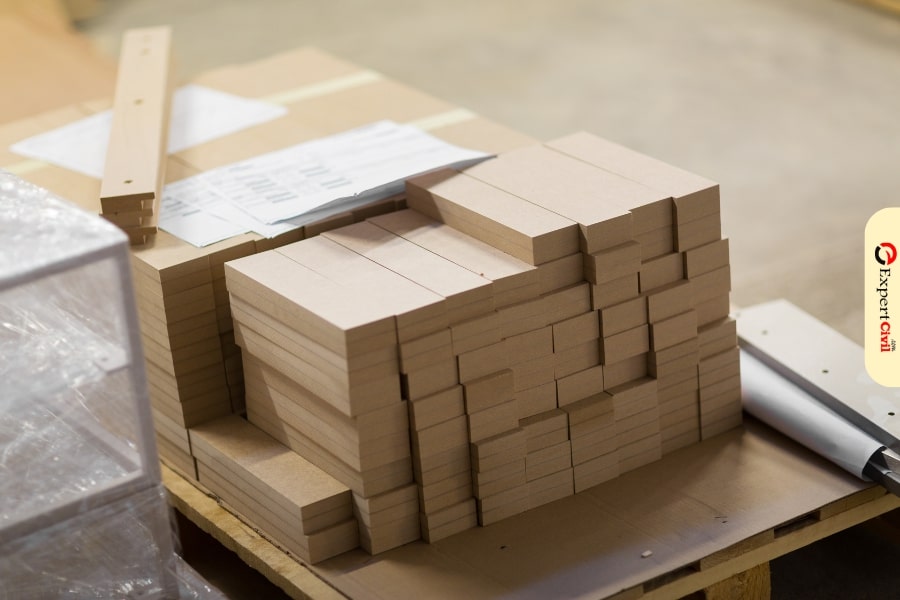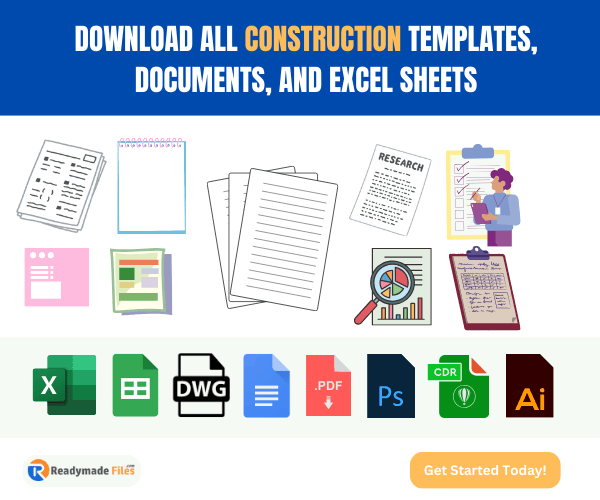What is MDF wood?
MDF wood is composed of Wood-mill waste, sawdust, and wood shavings. These materials are crushed into a fine powder. Then, it is dried to eliminate moisture. After drying, it is combined with resins and pressed into flat panels. MDF wood is much denser, smoother, and harder.

MDF is completely free of holes, knots, and splinters. MDF wood is a DIY building material. It is used as sheet material for furniture and cabinetry. This wood type is very adaptable. That’s why; it is an excellent choice for a wide range of projects.
MDF full form
MDF is abbreviated as Medium Density Fiberboard. The residues of both softwood and hardwood make this a type of wood.
Also Read: Types of Wood Veneer
Uses of MDF Board
1. Fire Resistance
MDF boards have excellent fire-resistant qualities. These boards are used to provide fire protection. In construction projects, MDF is commonly used as fire-resistant material. Commercial and household buildings can be made from a variety of MDF materials.
2. Furniture
Many companies use MDF boards to create a variety of furniture products. They are more affordable compared to real wood.
Fiberboard is used in furniture manufacture because it is less expensive. Nowadays, people prefer fiberboard furniture due to its cost-effectiveness.
3. Vapour Repulsion
Many commercial and residential structures use MDF boards as vapor barriers. This fiberboard can withstand dampness for an extended period. These boards prevent moisture from entering the home. So, the cost of power decreases due to less heat.
4. Cabinetry Use of MDF Board
The MDF board is most used for cabinetry work. It is used in residential interior carpentry. Cabinets are constructed of MDF board with laminated wood on top of them. Kitchen cabinets and shelving units are made of MDF board. Also, it is used in laminated timber flooring and door framing.
5. Roofing
Fibreboard is mostly used for residential roofing systems. This fibreboard has a high level of weather resistance. These boards serve as the best materials to use in shingle backing.
It can be used for internal wall sheathing tasks in homes. Fibreboard is a versatile and long-lasting material. So, it is used for interior and exterior decoration of homes.
6. Soundproofing
MDF boards can also serve as a sound barrier within a home. It contributes to making the house quieter. MDF board is used in many sound speaker manufacturing firms’ products.
These fiberboards can absorb sound and reduce internal vibration. MDF boards are also used in offices, newsrooms, and apartment buildings.
Properties of MDF board
MDF binders are employed in the production of higher-quality products. Binders include chemicals like urea melamine formaldehyde and urea melamine formaldehyde.
The wheat straw of varying grades and resin requirements were used to manufacture MDF. At that time it was referred to as Straw Medium Density Fibreboard (SMDF).
The properties analyzed of MDF are:
- Internal bond strength
- Thickness
- Modulus of rupture
- Elasticity
- Modulus of elasticity
- Swelling
- Water absorption
Advantages of MDF board
1. MDF is hard
MDF is comprised of wood. It has a completely different structure. An MDF board cause hurdle if you attempt to bend it. Because of this, wood has the benefit over its rival. Of course, the board will eventually sustain harm if submerged in water.
2. Cost-effective and Easy Application
MDF boards are typically less expensive than real wood. MDF has easy application in a construction project. So, people can prefer it over real engineered wood.
3. Easier to paint and seal
Unlike solid wood, engineered wood has no distinct grain or character. This makes MDF simpler to sand and prime. So, this wood has a smooth appearance to your woody projects.
4. Best for cabinetry
There is no denying the benefits of using engineered wood for cabinet doors. Interior designers have a variety of options due to flexibility. MDF has enhanced moisture resistance ability. MDF varieties are used for kitchen and bathroom furniture.
Disadvantages of MDF board
1. Easy to damage
MDF’s exterior surface and core are almost the same. When applying any exterior pressure, it causes dents. Outside external forces applied to MDF wood cause damage to its surface.
A cautious and sensitive approach is necessary when repainting MDF’s furniture. Damage to MDF is irreversible. So, extra care should be given to these fiberboards.
2. Heavyweight
Many people mistakenly believe that solid wood is heavier than MDF. But in reality, MDF weighs more than real wood. That is why a flat pack kitchen requires more anchors and additional support. Support of anchors is needed for mounting shelving and cabinets to walls.
3. Vulnerable to extreme heat
Wax and resin-like substances are used to make engineered wood. Because of this, MDF units shouldn’t be left near heaters, ovens, or fireplaces.
4. MDF can’t support too much weight.
If you put too much weight on MDF boards, they may drop. This material is not used for support. Solid wood and MD are combined for support is a creative option.
What is particle board?
MDF’s precursor is particle board. Sometimes, it is referred to as chipboard. It has a basic variation of MDF. The scrap from sawmills is used to make particle boards. Then, the product is strengthened by the inclusion of chemicals.

This makes them insect-proof, fireproof, and waterproof materials. After that, particle boards are sliced and shaped to make a variety of structures.
MDF vs Particle Board
| Parameters | Medium Density Fiberboard (MDF) | Particle-board |
| Density | MDF board has a high density as compared to particleboard. | Particle board has a low density compared to MDF. |
| Durability | This fiberboard is durable and long-lasting. | Particleboards are less long-lasting material. It is little durable compares to MDF. |
| Moisture | MDF has greater water resistance as compared to particleboard. | Particle board is low water-resistant material. |
| Price | MDF is an expensive material. | Particle board is cost effective material compared to MDF. |
| Look | This board has the same grains of wood. So, it has a shiny finish and smoothness properties. | It does not provide a shiny and smooth surface. |
| Strength | It has greater strength as compared to particleboard. | Particle-board is not very strong as MDF Board |
| Weight | It is heavy. | It has a low weight as compared to MDF. |
| Lifespan | Its shelf life is more than 10 years. | Its shelf life is more than 25 years. |
Particle Board vs. OSB
| Parameter | Particle board | Oriented Stranded Board (OSB) |
| Ease of Working | Particle board is easier to cut as compared to OSB. | It is easy to cut but heavy to carry. |
| Capacity to take paint | Particle board has less capable to take paint on their surface. | OSB can paint it well with the primer. |
| Strength | The particle board is less strong as compared to OSB. | It is stronger than particle board. |
| Cost-effectiveness | It is cost-effective material. | It has a low cost as compared to plywood. |
| Water Resistance | This material has no water resistance. | OSB is no water-resistant material. |
| Eco-Friendly Material | Particle board is not proven an eco-friendly material. | It is an eco-friendly material. |
Which is better MDF or particle board?
| MDF Board | Particle Board |
| 1. It is more expensive than particle board. | 1. It is cost-effective material. |
| 2. It gives high quality to wood projects. | 2. It gives the normal quality of woody projects. |
| 3. This board has high strength as compared to particle board. | 3. Particle board material has low strength. |
| 4. Its composition has wood-mill waste, sawdust, and wood shavings | 4. The particle board is made up of sawmill scrap. |
Also Read: Difference between Plywood and Blockboard
FAQ
How particle board is made?
An engineered wood product is called particle board. It is created from waste materials. It includes wood chips, sawdust, and shavings.
The recycled wood products are combined with resin. After that, it is pressed into sheets at a high temperature. Then, it is shaped to make a variety of structures.
What is particle board used for?
Particle boards are used to create ready-made furniture. In particular, when combined with parquet flooring, it is ideal for flooring.
It makes a great filler material i.e for artificial ceilings. Particle board is a common material for sound studio walls because of its strong insulating qualities.
Is particle board toxic?
Particle boards are toxic due to some formaldehyde levels in them. The United States Department of Housing and Urban Development conducted an assessment. They discovered that these fiberboard materials had sources of formaldehyde emissions.
This chemical becomes toxic for many consumers and woodworkers. It means that a large portion of the furnishings may contain small amounts of formaldehyde.
Is particle board recyclable?
Yes, particle board material is recyclable. It is made up of recycled materials. It is an excellent choice for people to lessen their influence on the environment.
When was particle board invented?
In Germany, particleboard was invented. In the 19th century, the first substitute of plywood was discovered. Glue is used to hold together thin veneers of solid wood to create plywood.
Why is MDF banned in America?
MDF is prohibited in the US due to its formaldehyde content. Illegal finishing paints are used for painting MDF. That’s why it is banned in the United States.
Conclusion
In short, this article gives an overview of other types of materials besides plain wood. There are always specific purposes for each alternate type of wood. You must be aware of the appropriate state for each type. Also, there are various kinds of wood and their supporting structures.
To cover every one of them, you would go through this paper. We’ve covered a variety of topics related to MDF, particle board, and OSB. It should help you with your future woodworking projects. So, it will have a significant impact on the project’s overall success and quality.
Also Read: Types of Wall Panelling


Leave a comment